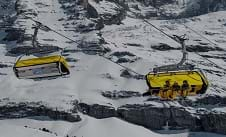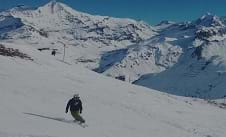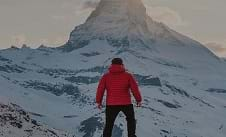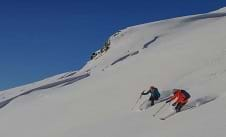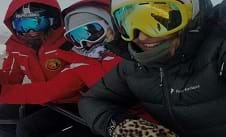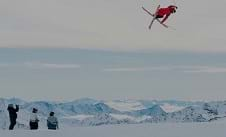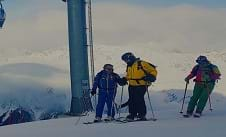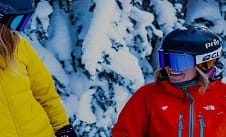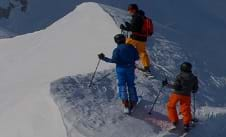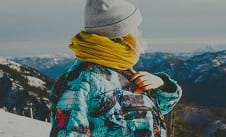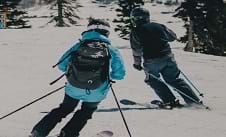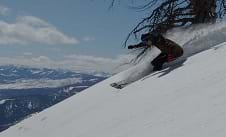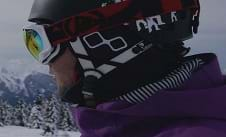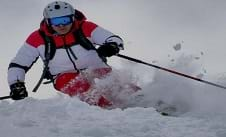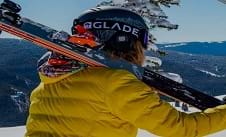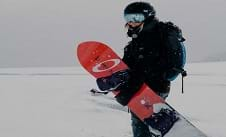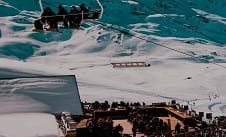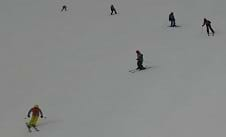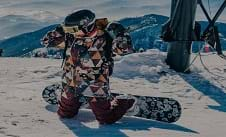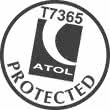Ski & snowboard trousers guide
Of course, no ski outfit is complete without a reliable pair of ski trousers. Choosing the right ski trousers or salopettes is key to making sure you stay dry, warm, and comfortable. No one wants to have to go home soaking wet before après has even started and miss all the fun. Ski trousers are as necessary as a ski jacket, and the importance of a quality pair is key to enjoying your holiday.
Similarly, to ski jackets, there are some minor differences between ski and snowboard trousers. Snowboard trousers tend to be looser fitting to allow for more varied movement, whereas ski trousers tend to be more form-fitting. Either will work for both sports though depending on your personal preference and what is comfortable.
There are plenty of design options on the market, from the fancy flare to brace-style salopettes. Whatever your choice, make sure your ski trousers are long enough to cover most of your ski boots and offer enough mobility for flexing and bending at the knee. They will also need to have vents for temperature regulation and pockets because you can’t have enough pockets for skiing. Additional features include snow gaiters, which are an important ski/board trousers element as they stop snow from going up your legs.
The best material to look out for the outer layer when hunting down your sweet new salopettes is nylon or polyester. The membrane should be made from expanded Polytetrafluoroethylene (ePTFE) or Polyurethane (PU). The optional insulation layer is usually a synthetic blend. Choose trousers with seams to protect you from moisture seeping through. There is either critical taping or fully-taped. Critical taping is the least waterproof option, but enough to keep you dry, particularly ideal for spring skiing when the weather is warmer. Fully-taped are seamed internally and externally, which offers maximum protection in extreme weather conditions. If you prefer a lighter style, make sure you have a base layer underneath.
Among the best brands for top quality, ski trousers are Gore-Tex, The North Face and Salomon. For a decent, long-lasting pair of ski trousers, be prepared to spend anywhere from £85 - £500. There are some no-frills, cheaper options out there, so you can find some bargains from around £25. Go Outdoors, and Decathlon offer great deals.
with your own travel concierge. Don’t hesitate to drop us a line – we’ll
help plan your perfect Ski Holidays.
020 7770 6888 ← online or call ↴
020 7770 6888
Women’s ski trousers
There is a wealth of women’s ski trousers on offer and they don’t have to be bulky. From baggy, to straight legged, to flared and fitted, there is bound to be a style just for you. Depending on your preference as well, there are high-waisted, mid-rise, and low-rise options. For the fashion-conscious females, check out Perfect Moment for some top of the range ski trousers (with the price tag to match).
Ski pants don’t have to cost the earth though; Topshop’s ski collection has some chic bargain buys and TK Maxx. Ski trousers are an investment that will last you for years to come, so it is worth investing in a high-quality pair that you absolutely love. Some of the best brands for women’s ski pants include Roxy, Rossignol, and Columbia. Although TK Maxx, Decathlon and Trespass offer great-value alternatives.
Men’s ski trousers
Men’s ski and snowboard trousers are also available in a wide range and shapes and sizes and varying elasticity. Some popular brands among the male demographic are Columbia, Helly Hansen and The North Face. Along with waterproof and being comfortable fitting, breathability is an important factor in men’s ski trousers, as these allow water vapour to escape, thus keeping you cool when working up a sweat.
You can browse through the latest season of ski pants at Snow & Rock and Elis Brigham. Different leg lengths are quite rare when it comes to ski trousers but most should be easily shortened at a tailors.
Kid’s ski trousers
When learning to ski, kids spend a lot of time sitting in the snow, so maximum waterproofing is essential. Look for a high waterproofing rating of at least 12000mm. Kids’ ski trousers tend to be well insulated and waterproof, offering your little one maximum protection on the slopes.
Decathlon offers some great, affordable children’s options, so you don’t have to spend a fortune on good quality trousers that they will grow out of. Ski trousers for little skiers tend to have all the same features that adult ones do, including vents, pockets, snow gaiters and padding. Salopettes are great for youngsters, as they have a high back, making is less likely for snow to get in.
Key features of ski trousers
Ski trousers insulation
Most ski (or snowboard) trousers are made up of an uninsulated shell with lining for added warmth and comfort. For extra warmth, opt for ski pants with an insulating layer, which is generally made of fleece or synthetic fabric. Generally, skiers and snowboarders will choose to wear thermal leggings as a base layer rather than extra insulated trousers. Other features to keep you protected from the elements include high-waisted pants, bib pants and snow gaiters.
Ski trousers waterproofing
Your ski (or snowboard) pants should keep you protected from snow and rain. They need to be warm and most importantly, waterproof. Waterproof ratings will tell you how quickly your ski trousers will become soaked and risk the rest of your layers becoming wet. Ratings are measured in millimetres, and the higher the number, the more waterproof the trousers will be. Most ski pants will have a waterproof rating between 5, 000 mm – 20, 000 mm. However, you may find that some specialist waterproof materials like GORE-TEX aren’t rated using this system. Ski pants with higher ratings will also be more expensive.
Ski trousers FAQ:
Ski trousers can also be known as salopettes, ski pants, snow pants and snow trousers. Some brands refer to trousers with a bib front or high waist and shoulder straps as salopettes and the regular design as ski trousers or ski pants. Generally, ski trousers, ski pants and salopettes are the same.
Much like a ski jacket, the best ski trousers will be a good, mobile fit, warm and waterproff. Key things to look out for are:
- Waterproof protection and breathability
- Ventilation panels (usual toward the inner thigh area)
A base layer like a pair of leggings helps keep the heat in. Just be sure they’re thermal and, ideally wicking, to keep you drier. The same goes for underwear - wicking materials work wonders for comfort. Fabrics like merino wool are great for keeping the odour down too.
Different manufacturers of ski trousers will have different requirements, and no following these can lead to anything from compromised performance to completely writing off your expensive trousers. Read the label or check the manufacturer's website. You can buy technical cleaner for waterproof materials - try Nikwax Tech Wash.
Yes, ski trousers are waterproof. They'll have been rated by a hydrostatic head test which is defined by thousands of mm or sometime K. A higher rating (e.g. 20,000mm) will be more water-resistant than a lower rating (e.g. 5000mm).
Seams are another element to check- if they aren't taped, then water can seep in. Make sure higher-rated trousers are breathable though, otherwise you'll end up sweaty!
Salopettes, in French, refer to trousers with a high waist or bib and shoulder straps (similar to overalls). In contrast, ski trousers (or pants in North America) are a more standard or form-fitting trouser without the bib or straps.
Whilst the broad elements like insulation and hard-wearing materials will be similar, there are slight variations specific to each discipline.
Ski pants are generally more form-fitting whereas snowboarders need looser clothing for their riding position. You'll find the padding tends to differ too - with snowboard pants focused on the rear and knees as they bear the brunt of falls but also during strapping in. Ski pants focus more padding on the boot cuff area where there is more friction and pressure between the shin, boot and trouser.
The fit will come down to personal preference and riding style, but most ski trousers will be a closer fit as the average skier is looking for warmth and being more agile, not hampered by excess, billowing fabric. Ski boots are normally warn underneath ski trousers so the legs will be wide enough for this.
Most common designs will go over the cuff of the boots, making it harder for the snow to get into the foot/leg. That said, some have a thin sleeve/membrane inside the leg or have a cut/opening that has been designed to inside the boot.






